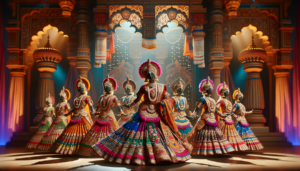Quickstep is a lively and energetic ballroom dance that has captured the hearts of dancers and audiences alike. This comprehensive guide will take you through the history, techniques, and competitive aspects of this captivating dance style.
Introduction to Quickstep
What is Quickstep?
Quickstep is a fast-paced ballroom dance that belongs to the standard category in DanceSport. It is characterized by its swift and light-footed movements, with dancers gliding across the floor in a series of quick steps and turns. The dance originated in the 1920s and has since evolved into a highly technical and competitive style.
Quickstep is known for its upbeat and joyful nature, with couples showcasing their skill, precision, and connection on the dance floor. The dance requires a high level of coordination, stamina, and musicality, as dancers must navigate intricate footwork and rapid changes in direction while maintaining a elegant and effortless appearance.
History of Quickstep
The origins of Quickstep can be traced back to the 1920s, when it emerged as a faster variation of Foxtrot. Influenced by the Charleston and other popular dances of the era, Quickstep incorporated elements of jazz and swing music, resulting in a lively and energetic style.
Over time, Quickstep evolved and became more refined, with standardized steps and techniques being established. The dance gained popularity in Europe and later spread to other parts of the world, becoming a staple in ballroom dance competitions and social dance events.
Basic Quickstep Steps and Techniques
Basic Steps in Quickstep
Learning the basic steps is essential for mastering Quickstep. The dance is built upon a foundation of quarter turns, lock steps, and chasses. Quarter turns involve rotating 90 degrees to the left or right, while lock steps require the feet to cross tightly behind or in front of each other. Chasses are a series of side steps that allow dancers to travel across the floor.
Other fundamental steps in Quickstep include the progressive chasse, the tipple chasse, and the running finish. These steps are combined in various patterns and sequences to create the flowing and dynamic movement that characterizes the dance.
Advanced Techniques in Quickstep
As dancers progress in their Quickstep journey, they can incorporate advanced techniques to add depth and complexity to their performance. These techniques include:
- Heel turns: Rotating on the heel of the foot to change direction smoothly.
- Pivots: Turning on the ball of the foot to execute sharp and precise rotations.
- Hops and runs: Adding elevation and speed to the dance through small jumps and quick, light-footed runs.
- Contra check: A sudden pause in the movement, creating a dramatic effect.
Mastering these advanced techniques requires dedication, practice, and guidance from experienced instructors. By incorporating these elements, dancers can elevate their Quickstep performance and showcase their skill and artistry.
Music and Rhythm in Quickstep
Choosing the Right Music for Quickstep
Music plays a crucial role in Quickstep, setting the tempo and mood for the dance. Quickstep is typically performed to uptempo music with a strong 4/4 beat, such as big band swing, jazz, or modern pop tunes with a swing feel.
When selecting music for Quickstep, it’s important to consider factors such as tempo, rhythm, and phrasing. The ideal tempo for Quickstep ranges from 50 to 52 bars per minute, allowing dancers to execute the fast-paced steps and maintain the lively character of the dance.
Understanding Quickstep Rhythm
Quickstep follows a distinct rhythmic pattern that consists of quick and slow steps. The basic rhythm is often counted as “quick-quick-slow,” with each “quick” step taking one beat and each “slow” step taking two beats.
| Beat | 1 | 2 | 3 | 4 |
|---|---|---|---|---|
| Step | Quick | Quick | Slow | – |
Understanding and internalizing this rhythm is essential for executing the steps with precision and musicality. Dancers must develop a keen sense of timing and learn to anticipate the musical phrasing to create a seamless and dynamic performance.
Quickstep in Competitions
Major Quickstep Competitions
Quickstep is a prominent dance style in ballroom dance competitions worldwide. Major competitions that feature Quickstep include:
- World DanceSport Federation (WDSF) Championships: The most prestigious international competition for amateur and professional dancers.
- Blackpool Dance Festival: An iconic event held annually in Blackpool, England, attracting top dancers from around the globe.
- UK Open Championships: A highly competitive event showcasing the best British and international talent.
These competitions provide a platform for dancers to showcase their skills, compete against the best in the field, and strive for excellence in Quickstep and other ballroom dance styles.
Judging Criteria in Quickstep Competitions
In Quickstep competitions, dancers are evaluated based on several key criteria:
- Technique: The accuracy, precision, and quality of the steps and movements.
- Musicality: The ability to interpret and express the music through the dance.
- Partnership: The connection, synchronization, and communication between the dance partners.
- Floorcraft: The effective use of space and navigation on the dance floor.
- Presentation: The overall performance, including style, charisma, and engagement with the audience.
Judges assess these criteria and assign scores to each dance couple, determining the rankings and winners of the competition. Aspiring competitive dancers must focus on honing these aspects of their Quickstep performance to excel in the competitive arena.
Learning Quickstep: Tutorials and Resources
Online Quickstep Tutorials
The internet offers a wealth of resources for those interested in learning Quickstep. Online tutorials, such as those found on YouTube channels like DanceSport Total, provide step-by-step instructions and demonstrations of Quickstep techniques and routines.
These tutorials cover a range of topics, from basic steps and footwork to advanced variations and styling. They often feature experienced instructors and competitive dancers who share their knowledge and insights into the art of Quickstep.
Books and DVDs on Quickstep
In addition to online resources, there are numerous books and DVDs available that offer in-depth guidance on Quickstep. These materials provide detailed explanations, illustrations, and practice exercises to help dancers improve their technique and understanding of the dance.
Some popular books on Quickstep include “The Ballroom Technique” by Imperial Society of Teachers of Dancing and “Quickstep: Intermediate / Advanced” by Walter Laird. These comprehensive guides cover the fundamentals, advanced techniques, and competitive aspects of Quickstep, serving as valuable references for dancers of all levels.
Conclusion
Quickstep is a captivating and exhilarating ballroom dance that combines speed, precision, and elegance. By understanding its history, mastering the basic steps and techniques, and immersing oneself in the music and rhythm, dancers can experience the joy and excitement of this beloved dance style.
Whether you aspire to compete at the highest levels or simply enjoy Quickstep as a social dance, dedication, practice, and passion are key to unlocking its potential. With the right resources, guidance, and mindset, anyone can embark on a thrilling journey into the world of Quickstep and discover the magic of this timeless dance.






